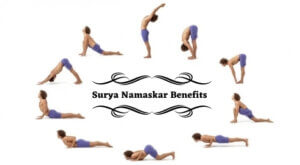Benefits of Surya Namaskar for Brain Tumor Recovery
Facing the challenges of a brain tumor can be overwhelming, but there’s a holistic approach that might offer support on the road to recovery – yoga for brain tumor recovery, specifically Surya Namaskar, commonly known as Sun Salutation. First and foremost, it promotes overall physical and mental well-being, which is crucial for recovery. Additionally, the controlled breathing and gentle stretches involved in Surya Namaskar can help to alleviate muscle tension and stiffness, which may be beneficial for individuals dealing with the physical effects of brain tumor treatment. Furthermore, Surya Namaskar can help reduce stress and anxiety, which are common concerns for individuals recovering from serious health issues. However, it’s important to consult a healthcare professional before beginning any new exercise routine, especially during surya namaskar as yoga for brain tumor recovery.
Enhancing Overall Strength and Flexibility
Surya Namaskar involves a sequence of 12 yoga asanas (postures) that target various muscle groups. Engaging in yoga for brain tumor recovery, such as Surya Namaskar, supports overall strength and flexibility. This gentle practice becomes a cornerstone in fostering physical resilience during the recovery journey, as it involves a combination of forward and backward bends, stretches, and balancing poses. These movements engage and strengthen muscles throughout the body, promoting better physical fitness and flexibility. Improved strength and flexibility are essential for overall health and can contribute to better posture, reduced risk of injury, and enhanced physical performance in everyday activities.
Improving Blood Circulation to the Brain
The dynamic movements involved in Surya Namaskar stimulate blood circulation throughout the body, including the brain. Enhanced blood flow to the brain can promote brain health and cognitive function. Improved blood circulation may also support the delivery of oxygen and nutrients to the brain, which is vital for overall brain health and recovery.
Reducing Stress and Anxiety Levels
Surya Namaskar incorporates rhythmic breathing patterns and a meditative aspect, which can help reduce stress and anxiety levels. The combination of physical movement and focused breathing can promote relaxation and a sense of calm, which is beneficial for managing stress and anxiety. Lowering stress and anxiety levels can positively impact overall well-being and may support the recovery process for individuals dealing with health challenges, such as brain tumor recovery.
Enhancing Mood and Emotional Resilience
Yoga and mindfulness for health are not just physical; they extend to emotional well-being. Regular practice of Surya Namaskar can have a positive impact on mood and emotional resilience. The mind-body connection inherent in yoga practices like Surya Namaskar can contribute to improved emotional well-being. Engaging in physical activity, combined with mindfulness and conscious breathing, can enhance mood, promote a sense of well-being, and encourage emotional resilience in facing the challenges of brain tumor recovery.
How to Practice Surya Namaskar Safely
Surya Namaskar, or Sun Salutation, is a series of yoga postures that provide a full-body workout and offer several benefits for physical and mental well-being. To practice Surya Namaskar safely, it’s essential to consider various factors that may impact an individual’s ability to perform the sequence effectively. This includes consultation with healthcare professionals, adapting poses for physical limitations, and incorporating gentle variations to suit different fitness levels.
Consultation with Healthcare Professionals
Prior to beginning different rehabilitation activities, such as yoga for brain tumor, it’s crucial to consult with doctors for brain tumor or specialists at a brain tumor hospital in India. Their guidance ensures a safe and personalized approach. Healthcare professionals, such as a primary care physician or a qualified yoga therapists, can provide personalized guidance and recommendations based on an individual’s specific health status. This can help ensure that Surya Namaskar is practiced safely and effectively while minimizing the risk of potential injuries or complications.
Gentle Variations to Suit Different Fitness Levels
Providing gentle variations allows individuals of different fitness levels to practice Surya Namaskar at a comfortable pace while gradually building strength and flexibility. For beginners or individuals with limited mobility, modifications to the traditional Sun Salutation sequence can be introduced. These modifications can include simplifying certain poses, using props for support, or reducing the number of repetitions initially to accommodate varying fitness levels.
Adapting Poses for Physical Limitations
Adapting poses for physical limitations is essential for ensuring that Surya Namaskar can be practiced safely by individuals with specific health considerations or physical challenges. For example, individuals with joint issues or injuries may need to modify certain poses to avoid exacerbating existing conditions. Adapting poses may involve using props such as yoga blocks or straps, adjusting the range of motion, or finding alternative postures that provide similar benefits without causing discomfort or strain. Remember, prioritizing safety and comfort is paramount during the practice of yoga for brain tumor recovery.
Integrating Surya Namaskar into a Holistic Recovery Plan
Surya Namaskar, as a form of yoga, can be valuable when integrated into a holistic recovery plan for individuals healing from brain tumors and other health challenges. A holistic recovery plan considers the whole person and seeks to address physical, mental, and emotional aspects of well-being. When integrating Surya Namaskar into such a plan, it’s important to recognize its potential benefits for physical health, mental well-being, and stress reduction.
Combining Yoga with Traditional Medical Treatments
In the realm of mind-body practices for brain tumor recovery, yoga stands out as a gentle and accessible option. Integrating Surya Namaskar into a holistic recovery plan involves combining the practice of yoga with traditional medical treatments. Yoga and mindfulness for health should complement traditional medical treatments by supporting physical rehabilitation, promoting relaxation, alleviating stress, and enhancing overall well-being. It’s crucial for individuals undergoing medical treatments to communicate openly with their healthcare providers about their intention to incorporate yoga practices like Surya Namaskar into their recovery plan, ensuring that it aligns with their overall treatment strategy.
Mindful Practice and Visualization
When incorporating Surya Namaskar into a holistic recovery plan, mindful practice and visualization can enhance the overall experience and benefits. Mindful practice involves being fully present during the practice of Surya Namaskar, focusing on the breath, movements, and sensations in the body. Visualization techniques can be integrated, where individuals visualize a positive outcome or envision their body’s healing process during the practice of Surya Namaskar. This combination of mindful practice and visualization can contribute to stress reduction, enhanced relaxation, and overall well-being, which are essential components of a holistic recovery plan.
Precautions and Considerations
When practicing Surya Namaskar, it’s important to consider certain precautions to ensure a safe and effective experience. Individuals recovering from brain tumors or other health concerns should pay attention to their physical limitations and consult with healthcare professionals before beginning a new exercise routine, including yoga practices like Surya Namaskar. Additionally, it’s essential to create a suitable practice environment, such as using a non-slip yoga mat and wearing comfortable clothing to support movement and relaxation during the practice.
Adjusting Intensity Based on Energy Levels
Individuals recovering from brain tumors may experience varying energy levels and physical capabilities. It’s important to adjust the intensity of Surya Namaskar based on energy levels, ensuring that the practice remains manageable and supportive of the recovery process. This may involve modifying the pace and depth of the poses, taking rest breaks as needed, and gradually increasing the intensity when energy levels permit. Listening to the body and honoring its current capabilities is crucial for a safe and beneficial experience.
Noting Warning Signs and Consulting Healthcare Providers
During the practice of Surya Namaskar, individuals should pay attention to warning signs such as dizziness, lightheadedness, or discomfort. If these warning signs occur, it’s important to stop the practice and consult with healthcare providers immediately. Additionally, individuals should communicate openly with their healthcare team about their intention to integrate yoga practices like Surya Namaskar into their recovery plan, seeking guidance on any specific precautions or modifications that may be necessary based on their health status. If you experience any discomfort or unusual symptoms during your yoga practice, don’t hesitate to consult with our doctors for a brain tumor in Mumbai at our Neurological Department at Jaslok Hospital.
In conclusion, practicing Surya Namaskar during recovery from brain tumors requires taking necessary precautions, adjusting intensity based on energy levels, noting warning signs, and consulting healthcare providers. By paying attention to these considerations individuals can practice Surya Namaskar safely and in a way that supports their overall well-being and recovery journey.









